#groundwater resources
Explore tagged Tumblr posts
Text
In rural Arizona’s La Paz County, on the state’s rugged border with California, the decision by a Saudi-owned dairy company to grow alfalfa in the American Southwest for livestock in the Gulf kingdom first raised eyebrows nearly a decade ago. Now, worsening drought has focused new attention on the company and whether Arizona should be doing more to protect its groundwater resources.
Amid a broader investigation by the state attorney general, Arizona last week rescinded a pair of permits that would have allowed Fondomonte Arizona, a subsidiary of Almarai Co., to drill more than 1,000 feet (305 meters) into the water table to pump up to 3,000 gallons (11 kiloliters) of water per minute to irrigate its forage crops.
In an interview with The Associated Press, Attorney General Kris Mayes said she thought most Arizonans see it as “outrageous” that the state is allowing foreign-owned companies “to stick a straw in our ground and use our water for free to grow alfalfa and send it home to Saudi Arabia. We just can’t — in the midst of an epic drought — afford to do dumb things with water in the state of Arizona anymore.”
Mayes, a Democrat, sought the revocations after she said her office had found inconsistencies in the permit applications. Mayes vowed to look into Fondomonte’s operations and water use last year after the Arizona Republic reported that the Arizona State Land Department leased the company thousands of acres of farmland for below market value.
Fondomonte did not respond to multiple requests for comment from the AP. Its lawyers have said previously that the company legally leased and purchased land in the U.S. and spent millions on infrastructure improvements.
Years of drought have ratcheted up pressure on water users across the West, particularly in states like Arizona, which relies heavily on the dwindling Colorado River. The drought has also made groundwater — long used by farmers and rural residents with little restriction — even more important for users across the state.
Saudi Arabia, struggling with its own water shortages in the past decade, restricted the growth of some forage crops in the country. That Fondomonte chose Arizona as a place to grow such crops has angered some in the state, which has faced two consecutive years of federal water cuts from the Colorado River, a primary water source for the state.
Officials from both parties have criticized the use of state water by foreign-owned entities, with Gov. Katie Hobbs, also a Democrat, saying in her January state of the state address that she, too, would look into the practice. The state’s groundwater, Hobbs said, “should be used to support Arizonans, not foreign business interests.”
That same month, Republican state legislators introduced a bill to prohibit sales of state lands to foreign governments, state enterprises and any company based in China, Russia or Saudi Arabia.
“There’s a perception that water goes to local uses,” said Andrew Curley, a professor of geography and the environment at the University of Arizona. “When you recognize it’s going far away, that the products and benefits of this water are exported overseas, that really provokes people’s attention.”
Foreign entities and individuals control roughly 3% of U.S. farmland, according to the U.S. Department of Agriculture. Canada is the largest holder — mainly of forestland. Fourteen U.S. states have restrictions on foreign individuals or entities owning farmland, but limitations vary widely and no state completely prohibits it.
Fondomonte also farms in California’s Palo Verde Valley, an area that gets its water from the Colorado River. Those operations have attracted less scrutiny. And it’s not the only foreign company that farms in the Southwest. The United Arab Emirates-owned Al Dahra ACX Global Inc. grows forage crops in Arizona and California, and is a major North American exporter of hay.
U.S. farmers themselves export hay and other forage crops to the Middle East — mainly to Saudi Arabia. China is the primary export market for U.S. hay.
In Arizona, renewed attention to Fondomonte’s water use is raising questions about the state’s lack of regulation around pumping groundwater in rural parts of the state.
Phoenix, Tucson and other Arizona cities have restrictions on how much groundwater they can pump under a 1980 state law aimed at protecting the state’s aquifers. But in rural areas, little is required of water users besides registering wells with the state and using the water for activities, including farming that are deemed a “beneficial use.”
“Frankly, I believe they are not doing their jobs,” Mayes said about Arizona’s Department of Water Resources’ oversight of rural areas. The Department declined to comment on the revoked drilling permits or the need for more groundwater regulation.
Mayes, along with hydrologists and environmental advocates, says more studies are needed of groundwater basins in rural areas — such as La Paz County, an agricultural county of about 16,000 people. Currently, Arizona doesn’t measure how much groundwater users pump in such areas, which means there is little understanding of how much water an operation like Fondomonte — or other farms — uses.
Almarai’s holdings in the Southwest are just one example of the farmland the company and its subsidiaries operate outside Saudi Arabia. It farms tens of thousands of acres in Argentina, which has also faced severe drought conditions in recent years.
Holly Irwin, a member of the La Paz County Board of Supervisors, has long opposed Fondomonte using water in the county. She said she’s fielded complaints from residents for years that it’s getting harder to pump water in nearby wells and has repeatedly asked the state to do something about it.
“We need to have some sort of regulation so it’s not all just being pumped out of the ground,” Irwin said.
#us politics#news#the associated press#ap news#Arizona#2023#saudi arabia#La Paz County#Fondomonte Arizona#Almarai Co.#drought#groundwater resources#foreign companies using domestic resources#Kris Mayes#Arizona State Land Department#Colorado River#Gov. Katie Hobbs#Andrew Curley#Department of Agriculture#Al Dahra ACX Global Inc.#Arizona Department Of Water Resources
6 notes
·
View notes
Text
call me artesian the way she drill me well till I overflow
#this is a little groundwater humor. for all of u who followed me for natural resource content#confined aquifer#artesian well
14 notes
·
View notes
Video
youtube
© Paolo Dala
The National Groundwater Information Center Of The Republic Of Korea
K water does not use groundwater sources, but they have a National Groundwater Information Center… a place where the monitor the water levels of all the wells around the country!
My colleague and I were joking that our country’s groundwater data monitoring is better than Korea’s… because we used to be administrators of the Philippine Ground Water Data Bank. Hahaha! But seriously, we are so jealous of their groundwater data bank.
#youtube#Video#National Groundwater Information Center#K water#IWRM#Groundwater#Water#On Assignment#Daejeon City#South Korea#Water Resources#Data Bank
0 notes
Text
الإمكانيات المائية الحالية في الضفة الغربية (فلسطين) وسبل تنميتها
الإمكانيات المائية الحالية في الضفة الغربية (فلسطين) وسبل تنميتها الإمكانيات المائية الحالية في الضفة الغربية (فلسطين) وسبل تنميتها الكاتب : الدعاجنة حجازي الملخص: تعاني الضفة الغربية شحاً كبيراً في المياه، ما اضطر الكثير من أهاليها للاعتماد بشكل دائم تقريباً على شراء هذه المياه نظرا لمحدودية مصادر المياه الموجودة والتغيرات المناخية التي تؤثر بشكل كبير على نوعية وكمية المياه، هذا ويتصف الوضع…

View On WordPress
#Aqueducts#Barrier#development#Groundwater#Palestine#Rain#Springs#Surface water#فلسطين.#water resources#West Bank#الموارد المائية#المياه الجوفية#المياه السطحية#الينابيع#الأمطار#الأحواض المائية#التنمية#الجدار العازل#الضفة الغربية
0 notes
Text
الإمكانيات المائية الحالية في الضفة الغربية (فلسطين) وسبل تنميتها
الإمكانيات المائية الحالية في الضفة الغربية (فلسطين) وسبل تنميتها الإمكانيات المائية الحالية في الضفة الغربية (فلسطين) وسبل تنميتها الكاتب : الدعاجنة حجازي الملخص: تعاني الضفة الغربية شحاً كبيراً في المياه، ما اضطر الكثير من أهاليها للاعتماد بشكل دائم تقريباً على شراء هذه المياه نظرا لمحدودية مصادر المياه الموجودة والتغيرات المناخية التي تؤثر بشكل كبير على نوعية وكمية المياه، هذا ويتصف الوضع…

View On WordPress
#Aqueducts#Barrier#development#Groundwater#Palestine#Rain#Springs#Surface water#فلسطين.#water resources#West Bank#الموارد المائية#المياه الجوفية#المياه السطحية#الينابيع#الأمطار#الأحواض المائية#التنمية#الجدار العازل#الضفة الغربية
0 notes
Text
0 notes
Text
Marathon County seeks local control over mining, wind energy projects, farm runoff
The letter states: “Marathon County asks that the State of Wisconsin return the tools necessary to exercise local control to the counties and municipalities best situated to address these issues.”
Damakant Jayshi The Marathon County Board of Supervisors will submit a letter to Wisconsin’s governor and the legislature seeking a return of local government control over environmental matters related to metallic mining exploration, wind energy siting and farm runoff. “Over time, through legislative and state agency action and preemption, local governments have become less adept to address…
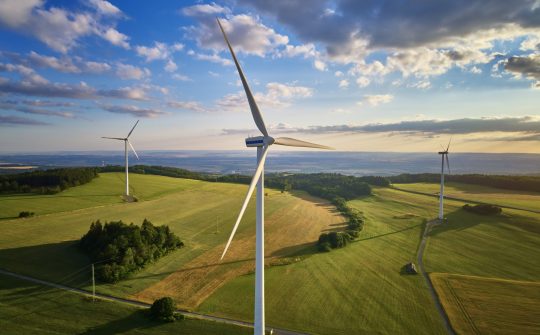
View On WordPress
#afternoon update#agricultural runoff#DNR#Easton Reef Deposit#exploratory drilling#farm runoff#Green Light Metals Inc.#Green Light Wisconsin#groundwater contamination#Jacob Langenhahn#Jean Maszk#Marathon County#Marathon County Board of Supervisors#Tim Sondelski#wind energy#wind turbines#Wisconsin Department of Natural Resources
1 note
·
View note
Text
The local population in countries that export bananas typically eat different varieties grown primarily by small farmers. The ones for the Americans and the Europeans, Cavendish variety bananas, are grown in huge, monoculture plantations that are susceptible to disease. The banana industry consumes more agrichemicals than any other in the world, asides from cotton. Most plantations will spend more on pesticides than on wages. Pesticides are sprayed by plane, 85% of which does not land on the bananas and instead lands on the homes of workers in the surrounding area and seeps into the groundwater. The results are cancers, stillbirths, and dead rivers.
The supermarkets dominate the banana trade and force the price of bananas down. Plantations resolve this issue by intensifying and degrading working conditions. Banana workers will work for up to 14 hours a day in tropical heat, without overtime pay, for 6 days a week. Their wages will not cover their cost of housing, food, and education for their children. On most plantations independent trade unions are, of course, suppressed. Contracts are insecure, or workers are hired through intermediaries, and troublemakers are not invited back.
Who benefits most from this arrangement? The export value of bananas is worth $8bn - the retail value of these bananas is worth $25bn. Here's a breakdown of who gets what from the sale of banana in the EU.
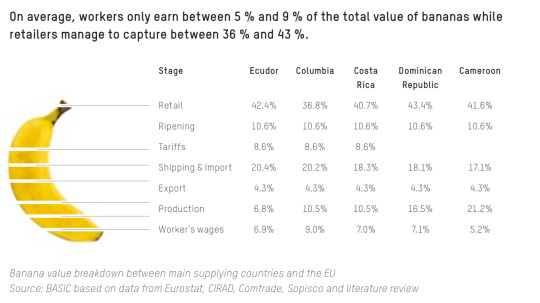
On average, the banana workers get between 5 and 9% of the total value, while the retailers capture between 36 to 43% of the value. So if you got a bunch of bananas at Tesco (the majority of UK bananas come from Costa Rica) for 95p, 6.65p would go to the banana workers, and 38p would go to Tesco.
Furthermore, when it comes to calculating a country's GDP (the total sum of the value of economic activity going on in a country, which is used to measure how rich or poor a country is, how fast its economy is 'growing' and therefore how valuable their currency is on the world market, how valuable its government bonds, its claim on resources internationally…etc), the worker wages, production, export numbers count towards the country producing the banana, while retail, ripening, tariffs, and shipping & import will count towards the importing country. A country like Costa Rica will participate has to participate in this arrangement as it needs ‘hard’ (i.e. Western) currencies in order to import essential commodities on the world market.
So for the example above of a bunch of Costa Rican bananas sold in a UK supermarket, 20.7p will be added to Costa Rica’s GDP while 74.3p will be added to the UK’s GDP. Therefore, the consumption of a banana in the UK will add more to the UK’s wealth than growing it will to Costa Rica’s. The same holds for Bangladeshi t-shirts, iPhones assembled in China, chocolate made with cocoa from Ghana…it’s the heart of how the capitalism of the ‘developed’ economy functions. Never ending consumption to fuel the appearance of wealth, fuelled by the exploitation of both land and people in the global south.
7K notes
·
View notes
Text
Water scarcity
Water is a necessary component of life. Although water is believed to be plentiful in nature, fresh water, on which humans rely, is not.
Water is a vital component of life. Although water is believed to be plentiful in nature, fresh water, on which humans rely, is not. Fresh water accounts for only 2.5% of the world’s water, with surface water accounting for 1.2% and groundwater accounting for 30.1%. A water source is considered to be stressed when there is strain on it. Water scarcity comes before water stress. Water shortage…

View On WordPress
#Environmental Engineering#fresh water#groundwater#Rainwater harvesting#surface water#wastewater reclamation#wastewater treatment#water#water resources#water scarcity#water sources#water stress#water supply
1 note
·
View note
Text
‘this is going to get worse before it gets better’: panama canal pileup due to drought reaches 154 vessels

the panama canal, a key route for global trade, is facing a crisis. 154 ships are waiting, with an average wait time of 21 days. drought has reduced the water level in the main reservoir to critically low levels, which has resulted in the canal's locks struggling to function.
40% of all u.s. container traffic travels through the panama canal every year. the current situation is a direct result of climate change and overuse of natural resources.
climate change: weather patterns have shifted, and the area is receiving much less rain than it used to. the lake that feeds the canal is refilling at a much slower rate.
overuse: development around the area has increased reliance on groundwater and freshwater sources. shipping traffic has surged, flushing more water down the canal.
each ship requires about 200 million liters to pass through, amounting to 2.8 billion liters per day at just 14 trips.
at peak season, that's 10 billion liters per day, all of it fresh water flushed into the ocean. gone. wasted. unusable.
the low water level creates two main issues: availability and pressure. emergency water conservation measures are in place, restricting the biggest boats movements and slowing down the entire process.
this ultimately leads to inflation. shit is about to become even MORE expensive.
this isn't just a problem for some boats or the shipping business. it's a reminder of how our actions and the changing climate are impacting the world in real and tangible ways. the panama canal is a microcosm of a global issue.
we have failed to recognize the interconnectedness of our world and we are paying the price. it will not improve under capitalism.
887 notes
·
View notes
Text
youtube
New MBARI research reveals the dynamic processes that sculpt the Arctic seafloor.
MBARI researchers—working alongside a team of international collaborators from the Korea Polar Research Institute, the Korea Institute of Geoscience and Mineral Resources, the Geological Survey of Canada, and the U.S. Naval Research Laboratory—have discovered large underwater ice formations at the edge of the Canadian Beaufort Sea, located in a remote region of the Arctic.

The recently discovered layers of ice are not the same as the ancient permafrost formed during the last ice age, but rather were created under present-day conditions. This ice is produced when deeper layers of ancient submarine permafrost melt, creating brackish groundwater that rises and refreezes as it approaches the colder seafloor. This discovery reveals an unanticipated mechanism for the ongoing formation of submarine permafrost ice.

The complex morphology of the seafloor in this region of the Arctic tells a story that involves both the melting of ancient permafrost that was submerged beneath the sea long ago and the disfiguration of the modern seafloor that occurs when released water refreezes. Learn more on our website.
96 notes
·
View notes
Text
While Palestinians have gone thirsty, Israelis had more than enough water to go around. The daily supply to Israelis and Jewish settlers is three to five times greater than to the average Palestinian household, whose consumption is almost 30 percent below the minimum amount recommended by the World Health Organization. Since they are all connected to Israel’s water network, the settlements have access to unlimited and highly subsidized resources; they can always fill their swimming pools and irrigate their vineyards, even during the region’s scorching summers. Under the 1995 Oslo Accords, Israel is entitled to siphon off a full 80 percent of the West Bank’s groundwater and 100 percent of the surface water from the Jordan River Basin. The limited allocation of 15 percent to the Palestinian Authority (PA) has not accommodated the massive growth in population in the Occupied Territories, which today is home to 75 percent more residents than at the time of the Accords’ signing. Mekorot, the Israeli water company, controls almost all of the distribution, and its monopoly ensures that water does not flow anywhere without its say-so. Not unpredictably, this stark power to turn on and off the tap is being used to accelerate the rate of Jewish settlement: without steady access to water in their villages, rural Palestinians are being pushed off their land and into the overbuilt and overcrowded cities.
506 notes
·
View notes
Photo
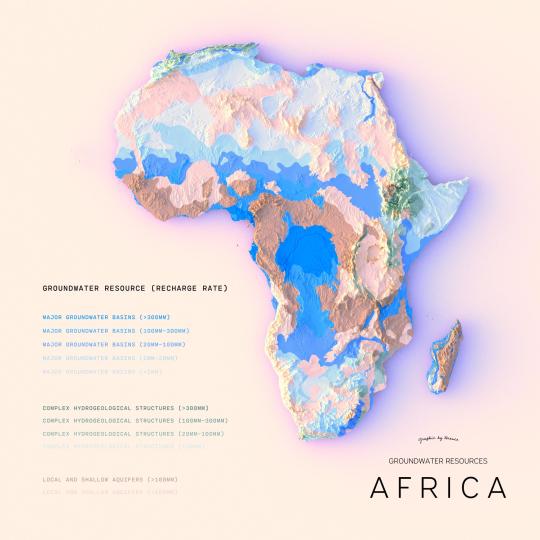
Groundwater resources of Africa
151 notes
·
View notes
Text
TO PUT AWAY A SWORD
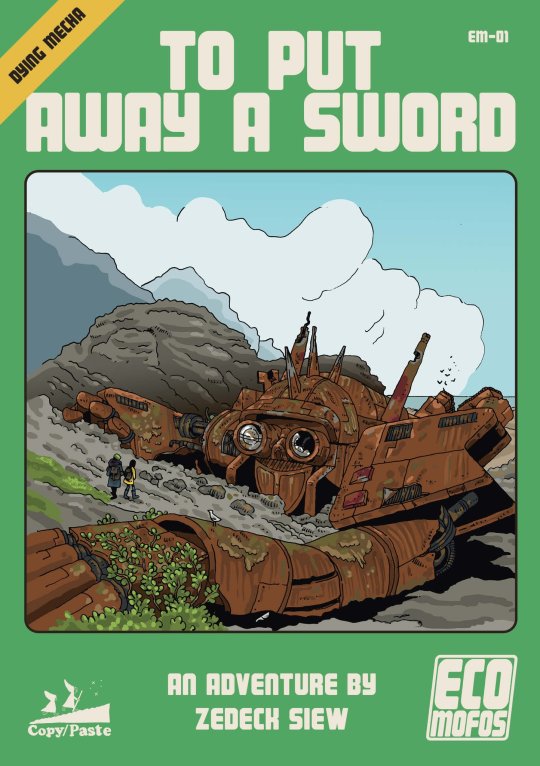
David Blandy + Daniel Locke's post-apocalyptic hopepunk TTRPG ECO MOFOS is back from the printers. Meaning it will soon be in our hands.
Am fairly hyped for it, because I wrote an adventure!
To Put Away A Sword is about the woes of building a home on poisoned earth. The terrible powers that hurtled us to the end of the world continue to bear bitter fruit in your garden.
You are villagers living under the shadow of a fallen giant mecha. Its reactors and warheads leak into your groundwater, poison your goats. What will you do about it? What can you do?
+
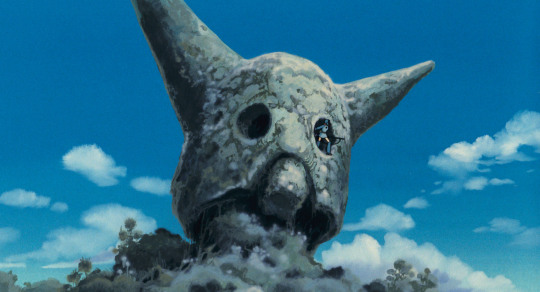
Mechanically it is a pointcrawl around your local valley. Not super complex, design-wise; but I was pleased with my gimmick solution for mapping both the adventure's dungeons:
Grab a mecha figure, pose it, place it on the game table; each part of the figure corresponds to a location in the dungeon key. Solves for stuff like relative orientation.
Easy!
+
To Put Away A Sword is me making a mecha adventure.
Disclaimer: I am not a mecha nerd. I am unfamiliar with most of the genre. Anything I know about Gundam I've absorbed by osmosis.
I was mainly into giant robots in childhood. Receiving a Macross figure for my birthday. Pouring over the manual for The Crescent Hawks' Revenge, which my brother left behind:

While I was not much a fan of mecha, I was very much a fan of Evangelion. I spent my middle teens obsessed with it. The biomechanical, pseudo-mystical stuff; the teen angst. I wanted to be Shinji. I thought trauma was so cool.
So cringe. Anyway:
One of the inspirations for To Put Away A Sword is the survivors-rebuilding-a-town-and-planting-rice sequence in Thrice Upon A Time; probably my favourite part of the whole franchise, now.
The joy and difficulties of trying to build your paradise in the weird ruins of the old world:



Yeah, the adventure has a lot of Evangelion in it. There's a Nerv HQ analogue to explore. There's a content warning for child soldiers.
+
The other inspiration for To Put Away A Sword is this piece of box art, an accessory set for Macross's iconic Stonewell Bellcom VF-1 Variable Fighter:

I don't know what this kind of arrange-your-missiles-in-front-of-your-fighter-jet photo is technically called. Hardware porn parade?
You see it often enough. Here's a real-life photo of the Lockheed Martin F35 Joint Strike Fighter:

Fairly or not, in my head I associate mecha with seeing copies of Jane's Defence in airport magazine racks. The genre feels like such a natural way to riff on the hyper-charged corpo-military-industrial complex.
After the brush war ends, and the natural resources extracted, and the ethnic cleansing concluded, and the profits announced, who gets to clean up after a Raytheon missile?
In To Put Away A Sword---you do.
+
Ultimately, as always, I am writing and designing from my lived experiences.

See that? The gas flare from the Hengyuan Refining Company? It is about 200 metres from my living room.
That gas flare surfaces constantly in the stuff I make. As I write this post I am breathing its acrid chemical smell. My nose itches. I was asthmatic as a child; I seriously worry about cancer, nowadays.
At night it lights up the sky like Barad-dur.
The plant obviously and continuously flaunts regulations. We've tried lodging complaints: with its corporate management; with the Department of Environment. Nothing has worked so far.
"A home on poisoned earth" is a visceral fact of my life.
+
To Put Away A Sword is wish-fulfilment, I guess? In the world of the adventure, at least, the forces that are poisoning your home are post-peak oil.
It is nice to imagine a reality where a kind of survival and flourishing is still possible. My partner Sharon and I talk a lot about imagining hope.

Last month she bought this small mecha-looking thing. A wireless camera! She built a little hut for it on our garden wall. It is trained, 24-7, at the gas flare.
Environmental activists we've met say video evidence of emissions is important. We'll see. We imagine it helping.
+
Anyway. David just sent me this photo of my adventure, in print:

Looking good. I hope folks play it and enjoy it.
Preorder ECO MOFOS and its adventure bundle >>>HERE<<<
107 notes
·
View notes
Text
While a relatively secluded ecosystem, the caverns of Arcuterra have expanded greatly over the last few million years. Consisting of a network of tunnels, chambers and crevices spanning for miles underground, the floor space of the caves have now exceeded those of a small island comparable to Earth's Tasmania-- and has gotten large enough to have several sub-biomes within itself, some levels more superficial and closer to the outside world where the abundance of nutrients trickling in allows the lush forest-like growth of subterranean pseudo-flora, and others beneath the upper layers where groundwater and detritus accumulates, forming stagnant, muddy swamps where, against all odds, life finds a way to thrive.

One of the ecosystem's most abundant animals are the feelerflits: the caverns' only flying animals. Descended from dipteran flies, their forebearers once did lose their wings in their initial colonization--yet over time re-evolved this ability through atavistic mutations once the caves had expanded enough to make flight advantageous again: though now, in pitch black darkness and without vision.
Feelerflits, however, managed to adapt by developing especially-hypertrophied feelers both on their antennae and their abdominal cerci, giving them the ability to detect movement both forward and behind. This, coupled by pressure sensors and long hairs on their feelers, allow them to discern their environment in flight, while olfactory and theroreceptor cells allow them to pick up thermal and chemical signals to recognize food, enemies, and conspecifics.
Most of the common feelerflits (Phantasmusca spp.) are generalist omnivores, feeding on decaying matter, shroomor spores and fungi, but some, in the abundance of resources and lack of competition, have ascended a rung in the food chain. The murksquitoes (Anophelomimus spp.) have become part-time parasites, supplementing their diet of mocklichen spores by biting larger animals such as daggoths, especially females that require additional protein in producing their eggs. Others, the darkdarters (Quadropteroides spp.) have become predators, preying on other feelerflits. With their halteres enlarged to resemble a second pair of wings but used as organs of balance instead, they are agile in the air, seizing other, smaller feelerflit species with spiny grasping forelimbs and using a sharp proboscis to pierce the bodies of their prey.
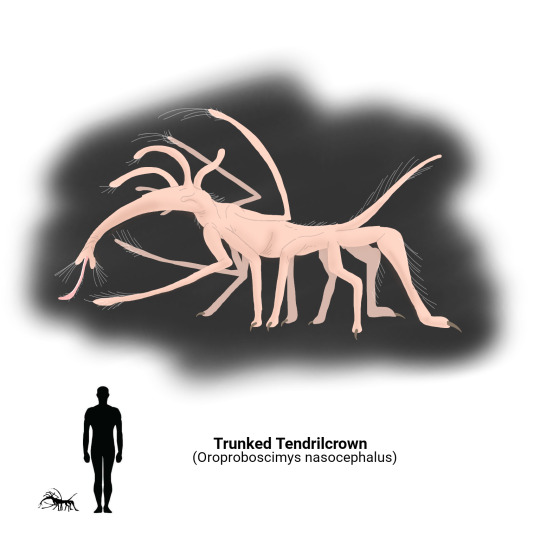
This abundance of insects, arthropods and other invertebrates has led to other unique specializations among the daggoths: the cavern systems' dominant troglofauna. Many are specialized insectivores, typically smaller species, but also some unusual outliers among the larger kinds.
One such creature is the trunked tendrilcrown (Oroproboscimys nasocephalus), a member of the cavehopper family that, unlike its other grazing kin, has adapted an elongated snout from the elongation of its lips, forming a trunk-like appendage with its mouth opening at the end, out of which emerges a long, sticky tongue equipped with small barbs, ideal for piercing through mocklichens to get at the interior, reaching into crevices to pull out rootlike mycelia, and most importantly to raid insect nests and feed on the inhabitants. Its trunklike appendage only contains its mouth, with its nostrils set far back behind the top of its head, keeping the vulnerable orfices far from reach of its biting insect prey.
Tendrilcrowns, like most other cavehoppers, are gregarious creatures that seek safety in numbers from predators like blindmutts and tendriltooths. They use their tail, atypically long for a daggoth, as a scent-marking organ to set territorial boundaries and identify related individuals. Yet, as their social behavior are merely for protection, their individual bonds are rather weak. When startled by predators, they individually flee with powerful thrusts of their leaping hind limbs, displaying little concern for their fellows whose company they only partake in to reduce the chances of individually being caught.
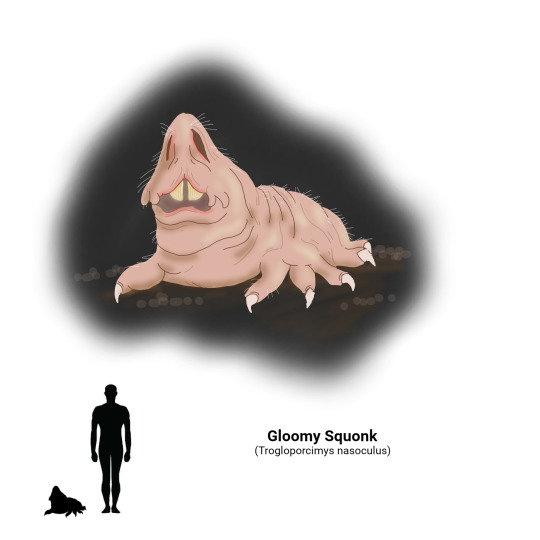
The cavehoppers may be agile and flighty creatures, but in the limited space, not all daggoths share their energetic means of movement. Some daggoths are content with a slower-paced life: especially those that live in the lower levels of the cave systems where fewer food is available and energy is better off conserved.
The gloomy squonk (Trogloporcimys nasoculus), one species of the gloomhogs in relation to the biblarodons, lives in the basement-levels of the cavern systems: where the muddy deposits gather into the large, wide chambers into a sort of underground marshland. Here, underneath the organic sludge, specialized filamentuous fungi grow in soggy, fibrous clusters, absorbing and converting the detritus back into biomass that, in turn, is the primary food of the gloomy squonk. Its ghostly eye-like orfices are in fact enlarged nostrils on its inverted, upturned snout, as it has adapted for spending much of its time wallowing in the subterranean swamps scraping off the fungi from the bottom, surfacing time and time to breathe. With larger nostrils as well as a markedly larger lung capacity, it is able to take in more air per breath, allowing it to make the most of the thin, oxygen-poor atmosphere so deep beneath the ground.
Its sluggish demeanor, large fat-storing body and glycogen-storing liver allow the gloomy squonk to survive for long periods without food, in one of the less-hospitable regions of the cavern system, where growths of its preferred forage follow irregular boom-and-bust cycles depending on how much nutrition is available from higher rungs. This, however, makes it an ideal potential meal for younger tendriltooths that may wander down lower crevices to avoid competition from aggressive and cannibalistic adults. However, while slow and typically placid, the squonk is not entirely defenseless. Its jaws, strong enough to tear fungal mycelia from rocky anchors, can also inflict a vice grip onto a would-be predator, after which it submerges into the muddy sludge in an attempt to drown its assailant.

Similarly, while some of the blindmutts became active, pouncing ambush predators, others, the cavegleaners, took on a more slow-paced lifestyle, wandering along as foragers and scavengers, picking on shroomors, insects, small daggoths and carrion, and thus alleviating competitive pressure from the tendriltooths, who now seldom consider them a threat and rarely bother attacking them.
The ridge-headed whiskersaw (Heliconasodon rubrilophus) is one such cavegleaner, often drawn to the leftover kills of tendriltooths to finish off the remains left behind once the predator is sated. Like the tendriltooth, the whiskersaw is equipped with sharp keratinous serrations on its nasal tendrils that function much like teeth. Yet now, with its foraging lifestyle, the whiskersaw now puts its false dentition to a strange use: coiling its two most prominent tendrils into tight spirals with the spines pointing outward, it then rotates them against one another as they uncoil back and forth: forming two abrading "polishers" that cleanly scrape the last residues of meat attached to bones, especially those out of reach of other predators. When uncoiled, these spiny appendages can also be inserted into hollows of bones to access the marrow, or be probed into the burrows of small prey to be extracted from their hiding spots.
The other conspicuous feature of the whiskersaw is of course the two fleshy ridges that adorn its head: the frontmost rims of which are made of highly-vascularized tissue that can be engorged and distended with specialized blood vessels to release a small amount of body heat. These are picked up by the thermoreceptors found on the nasal tendrils of other whiskersaws, in essence being used as a display organ by a species without eyes to see visual cues. Being mesothermic, like most daggoths, the display is a very energy-intensive effort in relative terms, and to the solitary creatures only means one of two things: a dominant male asserting his strength to a potential rival, or a receptive female advertising her readiness to breed. Also like the majority of other daggoths, the undeveloped but precocial young recieve minimal parental care, nursing for only a day or two before being deposited near abundant food sources conducive to their growth and survival.

A wide variety of large fauna now thrive among the drier regions of the caverns, which, while still smaller than surface animals due to the more limited space and resources, nonetheless reach impressive sizes for a cave-dweller. But the aquatic biomes of the caverns are not left out by such trends, as some aquatic daggoths have grown quite large, in particular the deeplake trogadile (Troglomyosuchus pennadactylus) which can reach lengths of up to a meter long or more.
While the tendriltooths are the top predators of the land, the trogadiles are the apex carnivores of the underground rivers and lakes where an impressive array of organisms thrive: aquatic insects, shrish, pescopods, hampreys and tubesnouts alike, dependent on a base producer of chemosynthetic bacterial mats and aquatic meatmoss, growing in thorny fronds like animal kelp. All of these are food for the trogadile: not a picky eater, it catches food with its muscular fused nasal lobes as well as two smaller tendrils equipped with sharp claw-like points, and using its extensible snorkel-like nostrils to breathe at the surface every few minutes, sometimes lying motionless just below the surface with only its snorkels exposed, waiting to strike at unwary prey.
Their specialized limbs, modified into flipper-like paddles, undulate rhythmically to propel themselves through the water, but, conversely, now make them practically immobile on land as grown adults, entirely helpless and vulnerable if beached. Young individuals, a few inches long at birth, however can manage a clumsy scuttle across dry land, enough to be able to disperse into other bodies of water. Once grown, they are permanently waterbound, though populations can still intermingle genetically despite isolated pools being separated, due to the amphibious capabilities of the juveniles.
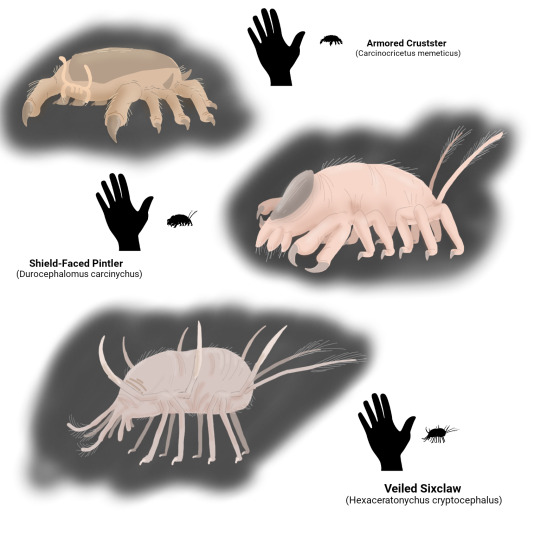
Many branches of the daggoth evolutionary family have thus produced a wide variety of some of the strangest and most alien-looking forms ever assumed by a rodent: to such an extent that many are scarcely ever recognizable as such. Many of these arise from derived lineages, but, from the gothtles, one of the most basal lineages, bizarre yet oddly familiar forms too have since emerged. These animals, in their basal forms once top predator of the caves, now find themselves at the bottom of the food chain, preyed upon by their distant kin: while some such as the xenomures adapted to flee and hide, others armed themselves with strange weaponry to to ward off and injure their enemies.
The veiled sixclaw (Hexaceratonychus cryptocephalus) is one such unusual species that, when threatened, conceals its face and sensitive nasal tendrils in a fold of thick skin as it curls itself up into a tight ball: leaving only six prominent defensive spines exposed. These long, horn-like projections are, surprisingly, actually elongated claws: attached to mobile, specialized digits, they can point in any direction to painfully stick into a predator's mouth, and, even when moving about and actively foraging, the sixclaw bears its weaponry in arms, raised above and behind its body to make it difficult to grab. Able to move together, they can pinch the tendrils and toes of an enemy, hard enough to draw blood, even if successfully picked up.
This ability for the digits to grip in junction has been put to good use by some species. The shield-faced pintler (Durocephalomus carcinychus) specifically has hypertrophied the first two pairs of its digits to use almost as grasping pincers, able to partly oppose and each equipped with a large, retractable claw. These serve it good use in excavating burrows, tearing apart food, defending itself and, most remarkably, used in intraspecific combat. Males can be up to twice as big as a female, and sport greatly enlarged claws and a larger keratinous facial shield that, while used in the females merely to protect their faces while burrowing, are defenses for males when they fight over territory, mates and resources, lifting each other up and tossing each other away as they tussle for dominance, with the losing combatant occasionally losing a few digits in the process.
These defenses, armor and burrowing abilities all reach their peak in the armored crustster (Carcinocricetus memeticus), a smaller and more placid relative of the pintlers that has evolved a more compact body and a single enlarged shield covering most of its back that, with its sharp-spined edges and smooth curved shape, makes it resistant to all but the most specialized of predators. Its powerful front claws are primarily used for digging, while its back, reinforced by a thick and sturdy spine with multiple interlocking vertebral processes, allow it great strength for its size, able to use it for leverage to wedge itself under large stones or into crevices, both to make itself inaccessible to enemies trying to fish it out of its hiding spots, as well as access small invertebrate prey taking shelter underneath.
#speculative evolution#speculative biology#spec evo#speculative zoology#hamster's paradise#biome post
127 notes
·
View notes
Text
youtube
You can grow tanks, rather than buy them, and they'll have a lot more water-harvesting capacity.
This video is about how living sponges (rain gardens) have far greater capacity than non-living manufactured water tanks, in that they utilize and infiltrate water during and immediately after rains to quickly make more room or capacity for the next rain - even if that rain comes just a few hours after the first rain.
Thus rain gardens (in this case, a water-harvesting, traffic-calming chicane or pull out) typically have much more potential for flood-control, groundwater-recharge, bioremediation (natural filtration of toxins), and heat-island abatement (due to the shading/cooling vegetation they grow and the cooling effect of the water transpiring through these "living pumps").
This works in any climate, but the vegetation changes as you change bioregions. The easiest path to success is to use plants native or indigenous to your area and site's microclimate. Go further, and select native plants that also produce food, medicine, craft/building materials, etc so you grow living pantries, pharmacies, craft suppliers, etc.
At minimum, make sure your tanks overflow to rain gardens, so that overflow is used as a resource. And place those rain gardens and their vegetation where you most need that vegetation, such as trees on the east and west sides of buildings to shade out the morning and afternoon summer sun for free, passive cooling.
The ideal, is that once this rain garden vegetation has become established the only irrigation water it will require is the freely harvested on-site water, so no importing/extracting of groundwater, municipal water, or other is needed. This way we can infiltrate more water into the living system than we take out - thereby enabling the recharge of groundwater, springs, and rivers; instead of their depletion and dehydration.
Get more info on how to do this and harvest many other free, on-site waters at:
https://www.harvestingrainwater.com/
where you can buy Brad's award-winning books, "Rainwater Harvesting for Drylands and Beyond" at deep discount direct from Brad at:
https://www.harvestingrainwater.com/s...
For more info on the community water harvesting and native food forestry work check out:
https://dunbarspringneighborhoodfores...
For more videos that expand on this one subscribe to this channel at:
http://www.youtube.com/user/Harvestin...
#rainwater
#waterharvesting
#permaculture
#rainwaterharvesting
#Brad Lancaster#solarpunk#permaculture#rain garden#water#rainwater harvesting#rainwater#water harvesting#rain water harvesting#rain water#garden#plants#native plants#native species#groundwater#Youtube
566 notes
·
View notes